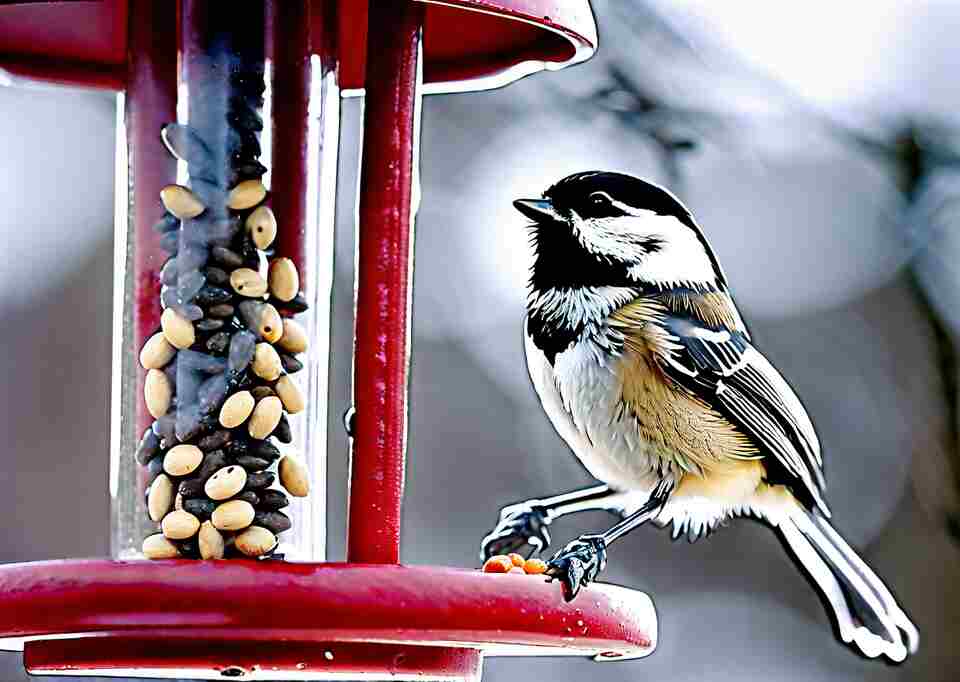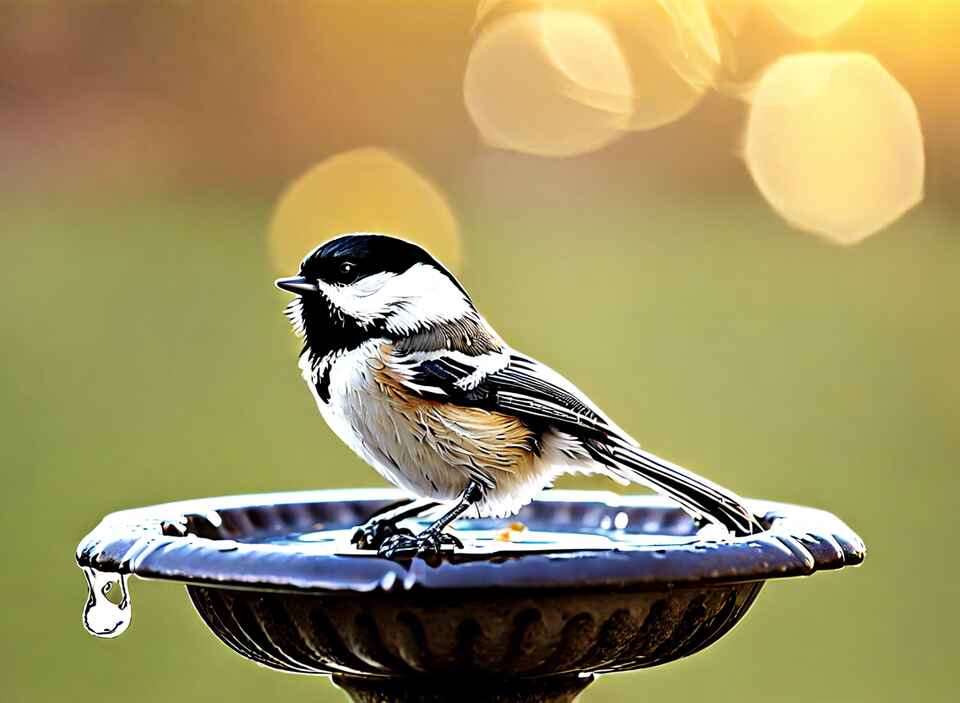Hey there! Ready to turn your yard into a chickadee paradise? Heck yeah, you are! Those little fluffballs are like the life of the party, right? Well, today, I’m here to spill the beans on how to make your place the hottest hangout spot for chickadees. Get ready for some fun tips and tricks that’ll have these tiny tweeters flocking to your yard in no time! Let’s make some chirpy magic happen!
Table of Contents
Key Takeaways:
- Create a welcoming environment with bird-friendly plants and water sources.
- Offer a variety of seeds, nuts, and suet as irresistible treats.
- Provide shelter and nesting spaces with birdhouses or dense shrubs and trees.
- Keep your yard safe by minimizing pesticide use and reducing window collisions.
- Sit back, relax, and enjoy the delightful presence of chickadees in your yard!
Crafting the Perfect Chickadee Habitat
Backyard Habitats that Entice Chickadees
Chickadees are delightful small birds that can bring a joyful presence to any backyard. These feisty little songsters are known for their distinctive “chick-a-dee-dee-dee” call and their acrobatic foraging behaviors. If you’re hoping to attract chickadees to your outdoor space, there are several strategies you can employ to create a welcoming habitat.
Provide Abundant Food Sources
Chickadees are omnivorous birds, meaning they enjoy a varied diet of seeds, nuts, insects, and even suet. To tempt these feathered friends, consider setting up multiple tube feeders with small perches or platform feeders are ideal for offering sunflower seeds, peanuts, suet, and mealworms—their favorite treats.. Be sure to keep the feeders clean and well-stocked, as a reliable food source is one of the key factors that will draw chickadees in.
Plant Native Shrubs and Trees
Chickadees thrive in areas with a mix of dense vegetation and open spaces. By incorporating native shrubs and trees into your landscape, you can create the perfect balance of cover and foraging opportunities. Look for species like serviceberry, dogwood, and oak trees, which provide both food and nesting sites for chickadees. These native plants also support a wide variety of insects, further enhancing the available food sources for your backyard birds.
Offer Suitable Nesting Sites
Chickadees are cavity nesters, meaning they prefer to build their homes in hollow tree cavities or birdhouses. Consider installing several well-placed birdhouses around your yard, ensuring they are the appropriate size (about 4 inches in diameter) and positioned in sheltered, shaded areas. You can also leave standing dead trees or snags in your landscape, as these natural cavities can serve as ideal nesting sites for chickadees.
Maintain a Diverse Habitat
Chickadees thrive in areas with a mix of habitats, including open spaces, dense vegetation, and water sources. By creating a varied landscape in your backyard, you can attract a wider range of bird species, including the beloved chickadee. Consider incorporating a birdbath or shallow dish of water, and ensure that there are plenty of perches, such as tree branches and shrubs, for the birds to rest and survey their surroundings.
Avoid Pesticides and Herbicides
Chickadees and other backyard birds are sensitive to the presence of chemical pesticides and herbicides. To create a truly welcoming environment, avoid using these products in your yard, as they can be harmful to the birds and the insects they rely on for food. Instead, embrace organic gardening practices and use natural pest control methods, such as companion planting and hand-picking weeds.
By implementing these strategies, you can transform your backyard into a haven for chickadees and other feathered friends. Remember, patience and persistence are key, as it may take some time for the birds to discover and become comfortable in their new environment. With a little effort and a deep appreciation for these delightful songsters, you can enjoy the charming presence of chickadees in your own backyard oasis.
Feeding Strategies: Providing the Right Foods for Chickadees
Attracting Chickadees to Your Yard: Essential Feeding Strategies
Chickadees are delightful backyard visitors, known for their cheerful calls and amusing antics. These tiny songbirds are not only a joy to watch, but they also play a crucial role in maintaining a healthy ecosystem by helping to control insect populations. If you’re looking to attract these feathered friends to your yard, understanding their dietary preferences and feeding habits is key.
Diverse Diet: Catering to Chickadee Cravings
Chickadees are omnivorous, meaning they consume a varied diet of both plant-based and animal-based foods. To attract them to your yard, it’s essential to offer a diverse menu that caters to their diverse tastes. These resourceful birds are known to forage for a wide range of items, including:
- Sunflower seeds: A chickadee favorite, sunflower seeds provide a high-calorie energy boost.
- Suet: Rendered fat mixed with seeds, nuts, or grains offers a nutritious and calorie-dense treat.
- Mealworms: These protein-rich insects are a delicacy for chickadees and can help them maintain their energy levels.
- Nuts and seeds: Provide a variety of options, such as peanuts, shelled pumpkin seeds, and unsalted almonds.
- Berries and fruits: Fresh or dried berries, as well as chopped-up apple or orange slices, can attract chickadees.
Feeder Placement and Maintenance
The location and type of feeder you choose can significantly impact your success in attracting chickadees. Opt for feeders that are easily accessible such as tube feeders, yet protected from predators and the elements. Hang your feeders close to dense vegetation, such as shrubs or trees, to provide a sense of security for the birds.
Regularly clean and maintain your feeders to ensure a safe and sanitary environment for your feathered visitors. This not only helps prevent the spread of diseases but also keeps the food fresh and appealing.
Seasonal Considerations
Chickadees’ dietary needs and feeding habits can vary depending on the season. During the colder months, when food sources are scarce, they may rely more heavily on high-fat and high-protein foods to maintain their energy levels and survive the winter. Offer suet, nuts, and seeds to help sustain them during these challenging times.
In the warmer months, chickadees may shift their focus to insects and spiders, which are essential sources of protein for raising their young. Supplement your yard with mealworms or a nectar-based feeder to cater to their changing needs.
Patience and Persistence
Attracting chickadees to your yard may not happen overnight. These birds can be cautious and may take time to discover and become comfortable with your feeding station. Be patient, and continue to provide a consistent and varied food source. Over time, you’ll likely be rewarded with the delightful presence of these charismatic birds.
Remember, creating a welcoming environment for chickadees not only brings joy to your backyard but also contributes to the overall health of your local ecosystem. By understanding their dietary preferences and incorporating the right feeding strategies, you can ensure that your feathered friends have the resources they need to thrive.
Conclusion
Providing a Welcoming Oasis for Chickadees: Backyard Birding
Creating a backyard sanctuary that attracts the delightful chickadee is a rewarding endeavor that can bring endless joy and connection with nature. By understanding the unique habitat preferences and feeding requirements of these beloved birds, you can transform your outdoor space into a vibrant, feathered oasis.
Enticing Backyard Habitats: How to Attract Chickadees
Chickadees are drawn to environments that offer the perfect blend of shelter, nesting opportunities, and abundant food sources. Start by ensuring your yard provides the essential elements these birds seek. Incorporate dense, multi-layered vegetation, such as evergreen shrubs and trees, which offer protective cover from predators and the elements. Native plants that produce berries, seeds, and insects are particularly appealing to chickadees, as they provide a reliable food source throughout the seasons.
Consider adding strategically placed birdhouses to your landscape, as chickadees readily take advantage of these artificial nesting sites. Positioning the houses in sheltered areas, away from direct sunlight and strong winds, will make them even more inviting. Maintain the birdhouses by cleaning them out annually and ensuring they are in good repair, as chickadees often return to the same nesting site year after year.
Feeding Strategies: Providing the Right Foods for Chickadees
Supplementing the natural food sources in your yard with strategic bird feeding can further enhance the attraction for chickadees. These resourceful birds have a varied diet, relishing a range of offerings from your feeders. Offer a selection of high-energy foods, such as suet, sunflower seeds, and nyjer seed, to cater to their voracious appetites.
Chickadees are particularly fond of peanuts, both whole and shelled. Hang feeders filled with these protein-rich treats in prominent locations within your yard, ensuring they are easily accessible for the birds. Remember to keep the feeders clean and well-stocked, as a consistent and reliable food source will encourage chickadees to make your backyard their regular dining destination.
A birdbath or shallow water source is another effective way to draw chickadees to your outdoor oasis. These active birds appreciate the opportunity to bathe and drink, especially during the hot, dry months. Place the birdbath in a sheltered, open area, and keep it filled with fresh, clean water to maximize its appeal.
Embracing the Joys of Backyard Birding
By creating a welcoming environment and providing the necessary resources, you can transform your backyard into a vibrant, chickadee-friendly haven. Witnessing these delightful birds flitting and foraging in your outdoor space can be a truly rewarding experience, offering a window into the captivating world of avian behavior.
As you observe the chickadees in your yard, take note of their unique characteristics and behaviors. Marvel at their impressive agility as they cling to feeders, their nimble movements as they dart among the branches, and their endearing calls that punctuate the air. Each interaction with these charismatic birds has the potential to deepen your connection with the natural world and foster a greater appreciation for the diverse wildlife that shares our living spaces.
Embracing backyard birding with chickadees is a pursuit that can enrich your life in countless ways. Beyond the visual and auditory delights, the presence of these feathered friends can have a calming and restorative effect, helping to alleviate stress and promote a sense of mindfulness and well-being. As you cultivate your backyard oasis, you’ll not only be providing a haven for chickadees but also creating a sanctuary for your own personal rejuvenation and enjoyment.
So, embark on the rewarding journey of attracting chickadees to your yard, and unlock the endless joys of this captivating hobby. By crafting a welcoming environment and catering to the needs of these remarkable birds, you’ll be rewarded with the privilege of observing their captivating antics and the profound sense of connection that comes with embracing the natural world right in your own backyard.





